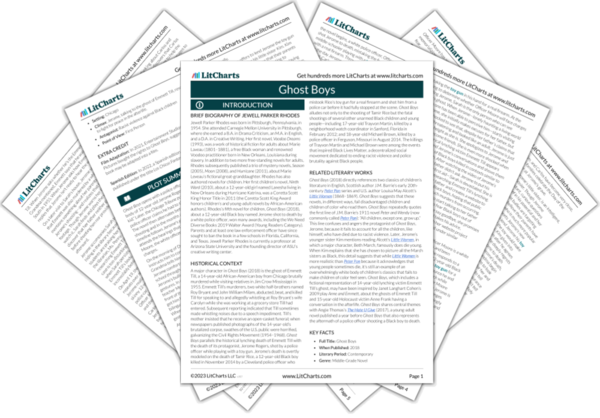In Ghost Boys, education might help build an anti-racist future—yet the novel shows how both disadvantaged and privileged children struggle to learn relevant lessons in school, though for different reasons. The novel’s protagonist, a 12-year-old Black boy named Jerome Rogers, struggles to learn lessons relevant to his life because the school in his impoverished Chicago neighborhood lacks resources. His school doesn’t have a librarian. While he would love to learn a foreign language, he only knows one or two Spanish words, which indicates that his school also lacks any foreign-language teachers. Moreover, Jerome spends a lot of his mental energy at school avoiding his bullies, Eddie, Mike, and Snap, who often beat him up on school property, another telling detail suggesting that the school can’t afford to hire enough staff to supervise the students adequately. After a white policeman, Officer Moore, mistakes a toy gun in Jerome’s hand for a real weapon and shoots him to death, Jerome meets the ghost of Emmett Till, a 14-year-old Black boy whose brutal 1955 lynching helped galvanize the Civil Rights movement—and readers learn that Jerome has never heard of him. This makes it clear that Jerome’s school’s history curriculum is seriously lacking.
After Officer Moore’s middle-school-aged daughter, Sarah, realizes she can see Jerome’s ghost, Jerome learns that she hasn’t been taught about Emmett Till or the Civil Rights Movement either. When Sarah seeks out Ms. Penny, the librarian at her relatively well-resourced school, for help researching Emmett Till, Ms. Penny at first tries to dissuade Sarah from educating herself on the grounds that Emmett Till’s story is too upsetting for a middle-schooler—even though the story is directly relevant to Sarah’s attempts at understanding why her father killed a child her own age. The novel’s ending implies that Sarah’s self-education about the racist murders of Black children in the U.S. will lead her to become an advocate for anti-racism as an adult—but the fact that she has to fight to learn about historically important racist violence in the U.S. shows how life-relevant lessons about racism are denied to privileged as well as disadvantaged schoolchildren, albeit for different reasons.
Education ThemeTracker

Education Quotes in Ghost Boys
Grandma dropped out of elementary school to care for her younger sisters. Ma and Pop finished high school. Me and Kim are supposed to go to college.

Unlock explanations and citation info for this and every other Ghost Boys quote.
Plus so much more...
Get LitCharts A+“Every goodbye ain’t gone,” Grandma says.
“In San Antonio, school’s always trouble. Everyone fights. Everyone’s afraid. I hope it’s better here.”
The tuna’s dirt dry. I almost choke. “We fight here, too,” I say, honest. “That’s why we have security guards. Metal detectors.”
“We could be friends.”
“That’s the stupidest thing.” I’ve never had a friend like Sarah. A white girl. I laugh, it’s so stupid. Die, and a white girl can be your friend.
“I’m not trying to be funny. Stay.”
She’s pleading. I feel sorry for her. My school doesn’t have any Sarahs.
I read the first line: “All children, except one, grow up.”
I frown. “What happened? Did he die?”
“No.” Sarah’s face reddens. “He doesn’t die. He stays a kid. He wants to stay a kid.”
“Maybe you shouldn’t know about it. At least for now. It’s terrible when grown men kill a child.”
“Like my dad?”











